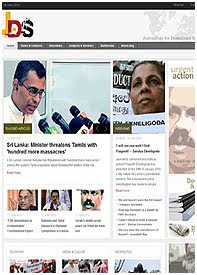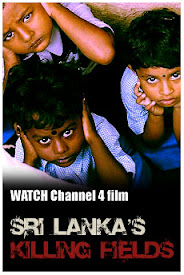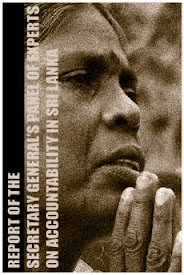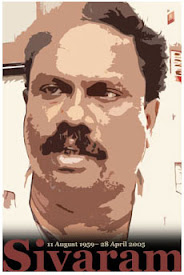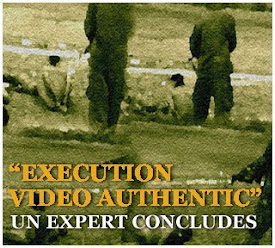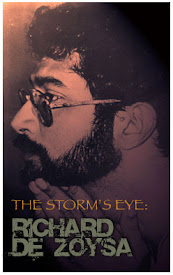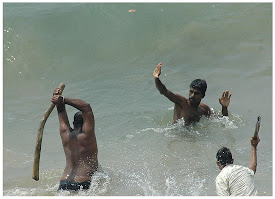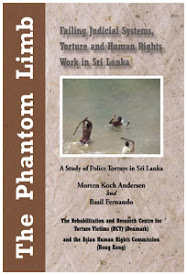
By Charles Haviland - Sri Lankan police have arrested 12 Buddhist monks who were demonstrating against the detention of the opposition politician, Gen Sarath Fonseka.
Late on Monday, a police spokesman told the BBC the monks would shortly be freed, but this could not be confirmed.
The arrests in the capital Colombo are another episode in the bitter fall-out of the so-called Fonseka affair.
The government incarcerated Gen Fonseka, the former army chief, after he lost the January presidential poll.
'Disgraceful'
He has now been two months in detention and a group of monks decided to vent their anger by demonstrating outside the city's main station.
Four had started a hunger strike on Sunday urging his release.
The police - including several in plain clothes - arrived to arrest the monks and, when they resisted, manhandled them to bundle them into vans.
The police spokesman said they had been obstructing people and that they were later taken to a magistrate while the hunger-strikers went to hospital.
The monks' lawyer, Nuwan Bopage, said the fundamental right to protest was being breached in a "disgraceful" way.
Tuesday will see the resumption of the court-martialling of Gen Fonseka on charges of unlawful political involvement while in uniform and of irregular procurement practices.
In spite of this, the retired general is standing in Thursday's parliamentary election.
Buddhist monks come from the Sinhalese ethnic majority and many are politicised.
A large number support the government, but those just detained are affiliated to a left-wing nationalist party which is now aligned to Gen Fonseka.
© BBC News
Tuesday, April 06, 2010
Sri Lanka arrests Buddhist monks over General Fonseka protest
Tuesday, April 06, 2010
Campaigning closes in Sri Lanka

B. Muralidhar Reddy - Curtains fell on the six-week campaign for the April 8 general election in Sri Lanka. Undoubtedly, it would go down as one of the dullest elections in the history of the nation.
The campaign has failed to generate much interest since the ruling United People's Freedom Alliance (UPFA) led by President Mahinda Rajapaksa is viewed as the victor.
Flush with victory in the January 26 presidential election, Mr. Rajapaksa was engaged in hectic campaigning across the nation.
Though there are 36 parties vying for 225 seats, the main fight is expected to be between the ruling combine led by Mr. Rajapaksa and the main opposition party the United National Party (UNP) led by Ranil Wickremsinghe.
The third alliance — Democratic National Alliance (DNA) — led by the former Army Chief and the defeated common consensus presidential candidate General Sarath Fonseka is also in the fray but with the retired General behind the bars, its prospects are not rated high.
While the 7,620 contestants from 36 recognised political parties and 301 independent groups vie for 196 seats in the 225-member Parliament, the remaining 29 slots are allocated through the National List based on the vote percentages political parties and independent groups obtain. Sri Lanka follows a proportional system of representation.
Meanwhile, in response to concerns expressed on General Fonseka's health condition the Army on Monday made arrangements for consultations from a senior chest physician, attached to the Chest Clinic, Colombo National Hospital, in the presence of medical officers at the Navy Headquarters where he is detained.
The Army said the move was initiated following allegations made by Mrs. Anoma Fonseka referring to an alleged “deterioration” in his health.
As per the Army, the chest specialist determined that the General had not been afflicted with any new condition as alleged, and he could still continue with his routine medication.
© The Hindu
Tuesday, April 06, 2010
MBC/MTV Attack: How do you react when the office is stoned?

by Mandana Ismail Abeywickrema - A staff member at MTV/MBC retracts how he and collegues reacted when hail of stones hit them last week.
For Rodrigo, a news manager in the Sirasa news room, and everyone inside the Sirasa network building the attack left them shocked and unable to figure out what had happened until the lapse of a few minutes after the attack.
When Rodrigo’s day in office commenced at 9.30 a.m., as in other days, there was nothing unusual about it. He went about preparing for the evening news bulletin and attended the daily de-brief attended by the station heads around 3 p.m.
After sorting out the news details, Rodrigo was back at his seat when everyone had heard some noises from the direction of the head office, the Capital Maharajah building, around 3.30 p.m.
“Unable to understand exactly what was going on, some employees started to run towards the fire exits. However, everyone was asked to remain in their floors,” he said.
About six heads from the news room including Rodrigo had then walked towards the entrance to their building, which was next to the head office building.
“There was protest outside the headquarters building and suddenly everything turned violent with the protestors pelting stones at the car park and the head office windows,” Rodrigo recounted, adding that they had immediately started to make calls to the emergency numbers including the police.
“’We are under attack,’ we said. The protest continued and a group of protestors started to walk towards out office and we ran for shelter. We ran to our gate.”
By this time Rodrigo started to see some of his colleagues and a few more from the head office injured by the stones thrown by the angry mob.
“The head office was like a war zone with broken glass bottles and stones strewn around broken windows and damaged vehicles. The vehicles in our car park however were moved away as soon as the stones were thrown to our compound,” Rodrigo said.
With the protestors moving forward towards them armed with stones and poles, Rodrigo and his colleagues had to think quickly to defend themselves.
“We had to protect ourselves and we had no option but to retaliate. We took the stones, bottles and poles thrown towards us by the protestors and threw it back at them in self defence,” he said.
About five minutes into the attack, the police had arrived at the scene.
“The police arrested 16 persons before our eyes. Gradually the protestors started to back down.”
It was now time for Rodrigo and his colleagues to return to the news room to prepare the breaking news bulletin.
“We had to assess the damage to do the story. Even by then we were still trying to figure out what had happened. The attack was unexpected. Even the still cameras in our head office building were damaged in the attack. Till everything was sorted out we had to prepare the initial breaking news bulletin,” Rodrigo said.
While Rodrigo and a few others prepared the breaking news bulletin, the others started to make the necessary arrangements to face another possible attack.
“Every one was gearing for another attack. We did not know what had happened and we thought they would attack us again. We looked at a second attack as well. Even now we are geared to face another attack. The staff has been made aware of the steps to be taken in case of another attack,” Rodrigo said.
For Rodrigo, the Monday evening attack was not the first time he had faced a violent attack against his institution.
“The attack on Sirasa in 2008 was scarier than this. In 2008, our Pannipitiya station was literally converted to a battle field. While fires raged on one side, the bomb squad had to be called to defuse the live grenades that were thrown into the premises. While trying to help douse the fire and salvage what ever we could from the studio, we had to attend to our injured colleagues as well,” Rodrigo recounted.
However, regardless of what attack may come against the institution, Rodrigo and his colleagues seem resolute in their stance of fighting back.
“We will continue regardless of all these attacks. We are committed to what we do,” Rodrigo said.
© The Sunday Leader
Tuesday, April 06, 2010
Sri Lanka's opposition vows to stop leader's poll plan

By Ranga Sirilal - Sri Lanka's opposition on Monday vowed to deny the ruling coalition a two-thirds majority at this week's parliamentary election, saying it would give an already powerful president too free a hand to rule.
President Mahinda Rajapaksa, fresh from a landslide re-election in January, has said he expects his United Peoples Freedom Alliance (UPFA) to get two-thirds of the 225-seat legislature at Thursday's polls.
That would give him the votes to change the constitution to his liking, a situation which produced the 1978 charter under former President J.R. Jayawardene that many view as flawed in terms of social equality and distribution of powers.
Rajapaksa's alliance looks assured of victory, riding high on momentum from his win in January, his defeat of the Tamil Tiger separatists in May last year and an economy resurgent since the end of the 25-year civil war.
On Monday, the central bank forecast 2010 economic growth of 6.5 percent, rebounding sharply from an eight-year low of 3.5 percent in 2009. Rajapaksa says economic revival is central to his plans for reconciling a country divided by ethnic strife and inequity.
Rajapaksa, like Jayawardene, has not said which changes he plans to enact, but the opposition warned he would show more of the autocratic streak they say he has displayed since he first came to power in 2005.
"It's not healthy for the country and will be a deadly attack on democracy to have the executive powers and two-thirds in parliament with one party. They will abuse the extensive powers," said Vijitha Herath, secretary for the Democratic National Alliance (DNA).
The DNA, the second largest opposition group, is led by the Marxist Janatha Vimukthi Peramuna (JVP) party. It includes retired General Sarath Fonseka, who lost his presidential bid against Rajapaksa in January and is now in jail.
OPPOSITION BACKED GENERAL IN PRESIDENTIAL RACE
The opposition rallied behind Fonseka, who led the army to victory over the Tamil Tiger rebels in a 25-year war but quit his post to challenge Rajapaksa.
But Fonseka got 40 percent to Rajapaksa's 58, and the military then arrested him and charged him in a court-martial for politicking while in uniform. He is still running for parliament, despite being in military custody.
The United National Party (UNP), by far the largest opposition party, still supports Fonseka but is running its campaign separately. General Secretary Tissa Attanayake said his party would get enough votes to block Rajapaksa's coalition.
"If the government gets the same results as the presidential election, they cannot get two-thirds," he said.
"They're just saying that to keep election momentum going. They know they have not addressed the peoples' issues such as the cost of living and democracy."
The campaign has been subdued compared to the presidential one both in terms of violence and tone. But gunmen sprayed bullets at campaigners on Monday, killing a 24-year old man in the first fatality of the current contest, police said.
The opposition, Western governments and rights groups have accused Rajapaksa's government of violating human rights, intimidation and failing to prosecute attacks on journalists and political opponents.
The government denies wrongdoing and says the opposition is trying to curry favour in Western capitals.
© Reuters
Tuesday, April 06, 2010
Sri Lanka: Archaeology sparks new conflict

Jeremy Page - Recent visitors to Kilinochchi, the former capital of the Tamil Tigers, had noticed something unusual — there was a single, new building standing among the bombed-out ruins of the abandoned city in northern Sri Lanka.
It was a whitewashed Buddhist shrine, strewn with flowers. “We thought it strange because there was no one there except soldiers — the civilians had all fled,” one of the visitors said.
Officers told them that the shrine had been damaged by the Tigers and renovated by the army — recruited largely from the Sinhalese Buddhist majority — after the rebels’ defeat a year ago next month. “It’s an ancient site,” Major-General Prasad Samarasinghe, the chief military spokesman, told The Times.
Many Tamil archaeologists, historians and politicians disagree. They say that the area had been populated for centuries by the ethnic Tamil minority, which is mostly Hindu. “There was nothing there at all,” Karthigesu Sivathamby, a retired professor of Tamil history and literature at the University of Jaffna, said.
The true origins of the site may never be known without independent analysis — which is impossible while the army restricts access to the area. Many Tamil community leaders fear that the shrine is part of a plan to “rediscover” Buddhist sites and settle thousands of Sinhalese across the north to undermine the Tamils’ claim to an ethnic homeland.
They also worry that such efforts will accelerate if the ruling coalition, led by President Rajapaksa, the country’s ethnic Sinhalese leader, wins a two-thirds majority in parliamentary elections due on Thursday.
“The Government is putting up new Buddhist shrines and building permanent housing for soldiers,” Suresh Premachandran, an MP from the Tamil National Alliance, said. “They are trying to colonise the area, to show it belongs to the Sinhalese.”
He said that the army was building housing for 40,000 soldiers and their families in the north, even before it has finished resettling 300,000 Tamils who were held in internment camps after the war.
The army says that it does have that many troops there but denies settling their families and says it is simply renovating old military camps — and occasionally renovating Buddhist and Hindu shrines.
“We’re just trying to protect the people and make sure the [Tigers] don’t come back,” General Samarasinghe said.
So begins a new chapter in a dispute that began with the birth of archaeology in Sri Lanka, under the British in the 19th century, and that grew into a civil war that lasted 26 years and killed 100,000 people.
When the British took control of the country in 1815, they were unsure of its ancient history but soon embraced the legend of the Mahavamsa — a text written by Buddhist monks in about AD500.
It suggests that the Sinhalese are descended from Prince Vijaya, an Aryan prince exiled from northern India in about 500BC, and that Tamils did not migrate from southern India until 200 years later.
That theory — still taught in schools — underpins the Sinhalese chauvinism that ultimately drove the Tigers to launch their armed struggle for an independent homeland in 1983.
In fact, archaeologists had discredited that after independence by excavating settlements in the north that dated from long before 500BC and showed similarities to sites in southern India — suggesting a much earlier migration.
When the conflict began, they were forced to suspend excavations and many Tamil archaeologists fled into exile overseas.
Since the end of the war, archaeology in the north has resumed — and with it the debate over the country’s ancient history.
“For three decades we haven’t been able to do anything in the north,” Senarath Dissanayake, the head of the Government’s Archaeology Department, said.
“Now we can find out about how ancient people lived here — their culture, economy, social background, living conditions and religion.”
He said that his department had identified 60 old sites in the north in the last year — and six completely new ones, dated between 300BC and AD1000.
Some Tamil academics question why the new sites are all from a period when Sinhalese Buddhist culture is thought to have flourished. Others want more Tamil archaeologists involved, as well as foreign experts or the UN, to ensure that the work is objective.
“The archaeological department is the handmaiden of the Government,” said one prominent Tamil scholar, who declined to be identified for fear of reprisals.
“The concern is that they’re going to identify these sites as Sinhalese, build lots of Buddhist shrines and tell Sinhalese people this is their lost land.”
The Government announced last month that 300,000 local and foreign tourists had visited the northern province since the war ended – and officials say that the vast majority were Sinhalese from the south.
Government archaeologists deny identifying sites on ethnic or religious grounds.
“The emphasis from the President is that there should be a balancing of Buddhist and non-Buddhist sites,” said Sudarshan Seneviratne, the head of the Central Cultural Fund, which finances archaeology. “He’s a smart politician. He knows how to cater to all communities.”
Mr Seneviratne accepted, nonetheless, that there were “parochial” forces who wanted to use archaeology for political purposes.
Principal among them on the Sinhalese side is the Jathika Hela Urumaya (JHU), a Buddhist monks’ party that is part of the ruling coalition, and has a powerful influence on Mr Rajapaksa.
Its clout was illustrated last month when the Government refused a visa to Akon, a Senegalese-American R&B singer who had been due to perform in Colombo this month.
Activists had protested over the video for Sexy Bitch, a song that showed bikini-clad women dancing around a pool, with a Buddha statue in the background. The protesters said that the Sri Lankan Constitution obliges the state to “give Buddhism the foremost place” and “protect and foster” the religion.
The JHU invoked the same argument in December when it presented 29 demands to Mr Rajapaksa, including one for him to rebuild dozens of Buddhist sites in the north. His response has never been made public but the JHU — which is led by a passionate amateur archaeologist — claims that the President concurred.
“He agreed to take immediate steps to restore Buddhist sites in the north,” Udaya Gammanpila, a senior JHU member, said. “He said the army and the archaeological department were already working on it.”
Even if that is untrue, the JHU can directly influence archaeology because Champika Ranawaka, its chief ideologue, is Environment Minister and his approval is required to excavate and protect sites.
Foreign archaeologists familiar with Sri Lanka say that the country — which is approximately 70 per cent Sinhalese and 20 per cent Tamil — needs to move past the ethnic issue.
“That debate will never be answered by archaeology,” Robin Coningham, a professor of archaeology at Durham University, said.
Tamil scholars say that that may not be possible with the JHU in government and the army empowered to rebuild Buddhist shrines on contentious sites.
“Archaeology has always been political in Sri Lanka,” said one Tamil historian overseas, who also did not want to be identified for fear of endangering relatives in Sri Lanka. “It’s no different today.”
© Times Online
This site is best viewed with firefox

Search
Is this evidence of 'war crimes' in Sri Lanka?
Archive
- ▼ 2010 (1312)
- ► 2011 (687)
Links
- Reporters Sans Frontières
- Media Legal Defence Initiative
- International Press Institute
- International News Safety Institute
- International Media Support
- International Freedom of Expression eXchange
- International Federation of Journalists
- Committee to Protect Journalists
- Asian Human Rights Commission
- Amnesty International
![Reblog this post [with Zemanta]](http://img.zemanta.com/reblog_e.png?x-id=0b228346-1ce6-4cfc-869e-0b921b65d5a8)
![Reblog this post [with Zemanta]](http://img.zemanta.com/reblog_e.png?x-id=d891f6b4-5699-4baf-be07-244756b5863e)
![Reblog this post [with Zemanta]](http://img.zemanta.com/reblog_e.png?x-id=ef22480e-d8b6-46e7-b8b1-3e45dd392f4e)
![Reblog this post [with Zemanta]](http://img.zemanta.com/reblog_e.png?x-id=4ac33e72-6cb8-4d5c-a7c1-90afe9ef6cd6)
![Reblog this post [with Zemanta]](http://img.zemanta.com/reblog_e.png?x-id=b3fe54de-d921-4526-bf36-ee257b0bf776)
